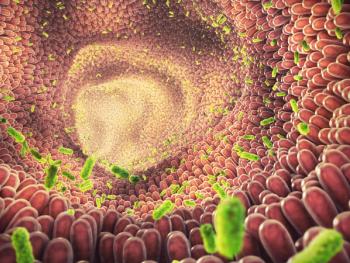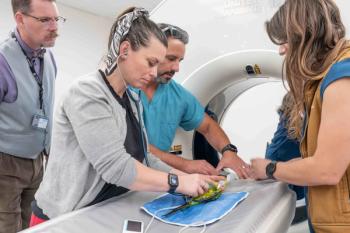
Gastrointestinal cytology (Proceedings)
Gastrointestinal (GI) cytology offers many advantages to the small animal practitioner in the assessment of patients with gastrointestinal tract disease.
Gastrointestinal (GI) cytology offers many advantages to the small animal practitioner in the assessment of patients with gastrointestinal tract disease. GI cytology is easy to perform, widely accessible (most practices will have the materials needed to acquire and prepare samples for GI cytology), is inexpensive relative to other GI-relevant diagnostic tests, and has the potential to provide definitive diagnoses for some patients with signs of GI disease. Some elements of GI cytology in small animal practice are likely underutilized as a diagnostic tool. This presentation will discuss the benefits of fecal flotation, fecal direct smears and wet mounts, cytology of rectal scrapes and impression smears or squash preparations of intestinal biopsies.
Fecal flotation
Fecal flotation will be familiar to most veterinary nurses, and its importance as a diagnostic tool for intestinal parasitism appreciated by all. Familiarity with the morphological forms of the various ova of the common small animal parasites (roundworms, hookworms, whipworms, coccidial organisms, flukes in some parts of the country) is key to optimal use of fecal flotation as a diagnostic tool in small animal practice. It is important to remember that fecal flotation may have applications in diseases of organs other than the GI tract, most commonly the respiratory tract. For example, ova of Capillaria aerophila, a lungworm of cats, can be detected with fecal flotation. Other respiratory parasite ova capable of being detected with fecal flotation include Oslerus osleri (tracheal worm of dogs), and Filaroides hirthi.
The solution most commonly cited as being superior for detection of the greatest number of possible GI and respiratory ova is zinc sulfate (ZnSO4), which can be purchased as a pre-made solution. The sensitivity of ova detection is improved further by combining ZnSO4 flotation with centrifugation. The combination of ZnSO4 flotation with centrifugation is more likely to allow detection of Giardia cysts than flotation alone; occasionally trophozoites can also be detected by ZnSO4 centrifugation. It is important to examine the prepared slide with both low and higher (40X) objectives as many protozoal organisms will escape detection if scanned only with a 4X objective. It is fair to say though that clinicians may have individual preferences, and the ZnSO4 solution may be insufficient to float some heavier ova (e.g. tapeworm ova).
Direct fecal smears
Examination of a stained smear of a fecal sample can be useful for the detection of numerous pathogens. Trophozoites of Balantidium coli, Entamoeba histolytica, and Giardia can all potentially be found on examination of a thin smear (usually best accomplished with a diarrheic stool sample), but often special stains such as iodine (Giardia), methylene blue (Entamoeba histolytica), or acid methyl green (Balantidium coli) are needed to optimize detection. Some bacterial pathogens such as clostridial spores, or Campylobacter species, will be evident with a Diff-Quick or Wright's-Giemsa type stained. Such stained direct smears may also allow detection of inflammatory cells (neutrophils, macrophages) and occasionally other intestinal pathogens that are found in the cytoplasm of these inflammatory cells (e.g. Histoplasma, Leishmania).
Wet mounts
Wet mounts of stool samples are most commonly used for the detection of intestinal parasites that are ciliated or flagellated and capable of movement within an aqueous medium. In addition to the trophozoites of Balantidium coli, Entamoeba histolytica, and Giardia, trophozoites of trichomonads such as Tritrichomonas foetus, a parasite responsible for causing large bowel diarrhea in cats and dogs, may be observed in a fresh or wet mount of a stool sample. A drop of watery stool sample may be placed directly on a microscope slide and a cover slip placed over the drop; the preparation should be thin enough to be able to read through. If the sample is too thick or opaque, addition of drops of 0.9% saline until appropriately diluted is recommended. The slides are typically examined under 10X or 40X objectives, focusing the higher power examinations for better examination of structures that resemble trophozoites. If the morphologic features are difficult to appreciate with thin wet mounts of stool samples, a stain as noted above could be added to the smear to help better identify observed organisms.
Rectal scrape cytology
Rectal scraping permits detection of a somewhat different set of diseases than typically identified with examinations of stool. Rectal scrapes tend to be best suited for animals that are suspected to have infiltrative diseases of the intestinal tract (inflammatory intestinal disease, intestinal neoplasia) or some infectious diseases (Histoplasma, Prototheca, Leishmania).
The goal of a rectal scrape is collection of a larger concentration of cells directly from the rectal wall. Thus, to perform rectal scrapes, the clinician or nurse will need one of an assortment of tools that can be used to collect these rectal samples. Rotation of a moistened cotton swab inserted into the rectum may collect sufficient cells for examination; the swab is rolled along a glass slide, and the slide stained or submitted to a clinical pathology laboratory for examination. One can use a gloved finger nail to "rake" the rectal mucosa and then smear or roll the fingertip along a glass slide. A spatula appropriate for conjunctival scrapes may also be quite suitable for collection of rectal mucosal samples with the spatula inserted into the rectum and like the fingernail technique, the tip angled into the rectal mucosa and raked over the mucosa to collect a sample. The collected material can then be deposited onto a glass slide and smears made. The author has also used small bone curettes to obtain rectal scrapes with excellent results. Again, any slides made can be stained (Diff-quik or Wright's-Giemsa) for immediate examination and/or submitted to an outside clinical pathology laboratory for examination.
Touch imprints or squash preparations of intestinal biopsies
An adjunct to endoscopic examination and histopathology, slides made by touching glass slides to pinch biopsy samples can be helpful for immediate assessment of the likelihood, or definitive diagnosis of, some important gastrointestinal tract diseases. To perform the technique, a pinch biopsy sample is removed from the biopsy forceps cup and placed on a glass slide. Using a needle to hold the tissue, multiple imprints using a second glass slide are made. The author will sometimes press the biopsy between two slides to make a type of "squash" preparation. The resultant slides can be stained as for rectal scrape cytology. This technique has been useful in the rapid diagnosis of lymphoblastic forms of intestinal lymphosarcoma and can hint at the diagnosis of some of the inflammatory intestinal diseases (lymphoplasmacytic or eosinophilic enteritis). Negative results, however, do not exclude any of those diagnoses, and histopathology will be preferred in most cases for definitive diagnosis and confirmation of cytologic impressions.
Summary
Additional examinations of stool samples, beyond fecal flotation, are easily performed, inexpensive and can provide nearly immediate information of diagnostic and potentially therapeutic value. Nurses in most small animal practices easily perform the techniques. Important to maximizing the efficiency of these cytology techniques is developing a familiarity with the morphology of the various ova, trophozoites or other pathogens, that can be detected with the various techniques, or submission of suspect samples to a clinical pathology laboratory.
References
Jergens AE, Andreasen CB, Hagemoser WA, et al. Cytologic examination of exfoliative specimens obtained during endoscopy for diagnosis of gastrointestinal tract disease in dogs and cats. J Am Vet Med Assoc. 1998;213:1755.
Little SE. Laboratory diagnosis of protozoal infections. In: Infectious diseases of the dog and cat. Greene CE, ed. Elsevier Saunders, St. Louis, 2006. pp 667-672.
Newsletter
From exam room tips to practice management insights, get trusted veterinary news delivered straight to your inbox—subscribe to dvm360.






